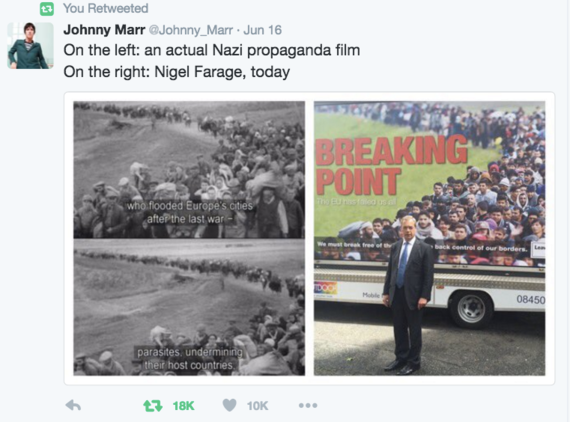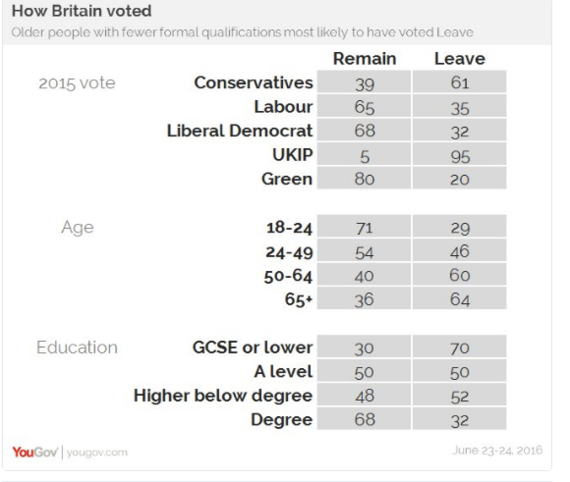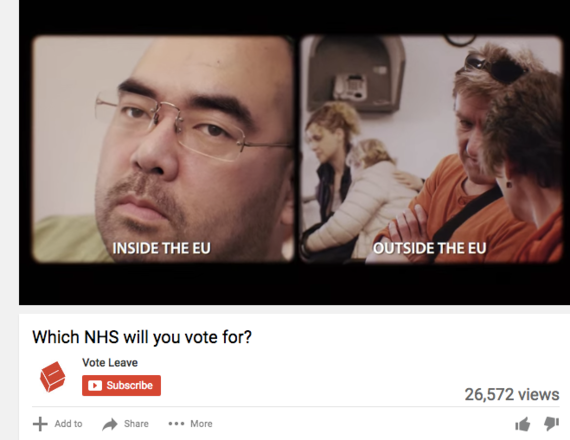Not everyone who voted to leave in last week's EU referendum did so based on the question of immigration. However, the vote was won off the back of a xenophobic marketing campaign. Its penultimate moment revealed an anti-refugee poster inspired by nazi propaganda. The "our borders are at breaking point" image was so offensive that it was reported to the police for inciting racial hatred by Unison's General Secretary David Prentis.

Photo: Twitter feed @_chrisdeleon
The consequence of Vote Leave's racist campaign has been a 57% rise in hate crime in the three days following the referendum results. It's as though every single racist decided it was OK to go and abuse anybody who didn't look like a white Briton. Let's just take a moment to accept that this figure only reflects hate crime that has been reported to the police. In my view, it is a conservative figure.
You only have to look at the hashtag #PostRefRacism to see how many incidents of racist abuse occurred since the referendum result was announced. When the first reports began to fill my Twitter feed on the Friday, it was difficult to say if these were isolated incidents or not. But within 24 hours, my feed was inundated with these accounts and it became clear to me that there was a direct correlation with the Vote Leave campaign. What was deeply disturbing to me was that these attacks weren't co-ordinated by one single group, they were happening at random, all over the place in the same time frame. The victims have been young and old, European and non-European.
How has the question "Should the United Kingdom remain in the European Union?" managed to take this country's race relations back at least 20 years? The Vote Leave campaign knew their target audience would not be able to grasp the complexities of our relationship to the EU. So, they aimed their propaganda at the lowest common denominator.
The term "Brexit" was quickly co-opted by Leave campaigners. An easy to understand term, to mean "Britain" and Exit". Labelling the EU Referendum "Brexit" became a simple message that the Leave campaign could sell to the populist vote.
Leave's main target audience was an easy sell. "Take Back Our Borders", "Take Back Control" and slight variations thereof were clear anti-immigration slogans repeated over and over again. The complexity of explaining the real issues: sovereignty, trade agreements, tariffs, political versus monetary union was stripped back to a very simple call to action. The message was delivered almost entirely through an "above the line" campaign and appeared on billboards, tabloid newspapers, television and radio -- traditional media consumed mostly by an older generation. The campaign knew its core audience and strongly targeted the "CDE 2" marketing segment. That's industry code for low income earners, mainly manual labourers and seasonal workers with little or no education. In a nutshell, poor people with very little job security and that's if they're in employment at all. In a post referendum YouGov poll, it was revealed that 70% of voters were 65 or older and had left school at 16 or earlier. Age, lack of education and low income were all key factors. It was demographics, not political party allegiances that determined the result.

Photo: Twitter feed @_chrisdeleon
The Leave campaign knew it had to capture a new audience. They needed to appeal to the customer who would be less inclined to buy into brand Brexit because of its association with UKIP and the extreme right. This softer side of the Leave campaign called for better funding of the NHS. The tactic used in this case was a slogan based in a lie that sounded like fact "Let's give our NHS the £350 million the EU takes every week".
I have to admit, I nearly fell for this advertisement. It wasn't immediately obvious which side of the debate it was coming from. I assumed (wrongly) that it was the Labour Party or one of the unions. Its gentle acoustic folk guitar soundtrack put me at ease and the split screen gave me an easy way to view what the NHS would look like in the EU versus out. I was drawn in until its subtle references to race came into play. At one point, the director cuts away to a really mean looking dark-skinned man giving dirty looks (In the EU) versus a happy looking blonde gentleman minding his own business (Out of the EU). In the end, the intimidating, dark skinned man gets seen before the vulnerable old white lady who's clearly in more pain than he is. The set up is meant to illustrate the point that certainly old white ladies should be seen to before "foreigners". Now, I'm pretty clued up on this stuff and I am hardwired to look out for the subtle nuances of racism in adverts, but someone less calibrated to this might not register the racist undertones.

Photo: YouTube
This barefaced cheek racism is doled out so casually with such little thought and it's not going to simply disappear next week or next month or next year. This is not some blip in the chart, this is the new normal for Britain. The rhetoric and propaganda delivered by the Leave campaign (both official and unofficial campaigners) has legitmised xenophobia in our mainstream culture and media. The opposing "Stronger In" camp sorely underestimated just how much the electorate would buy into xenophobic Brexit. The mothballed steel and mining towns, defunct port towns and the chronically underfunded rural areas on their peripheries all need someone to blame for the deprivation they have suffered at the hands of austerity. Someone who isn't like them is easiest to blame, easier to hate. The polls leading up to the vote consistently showed that the top issue for leave voters was EU migration and they still chose to run a campaign that didn't address this point directly.
"Advertisers who ignore research are as dangerous as generals who ignore the signs of the enemy." - David Ogilvy
The people in these areas are so radically disenfranchised, they're willing to believe any lie, they're willing to accept any scapegoat given to them in order to help them make sense of their lot in life. The scapegoat handed to them by the Eurosceptics is the immigrant. One only has to look at how nationalist fervour and economic strife following the Great Depression played out in 1930s Germany to see how close we are sailing to the wind.
